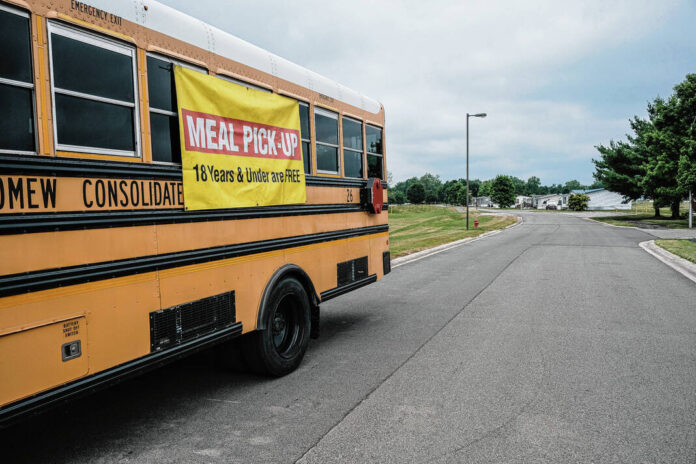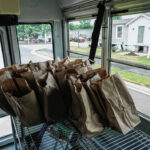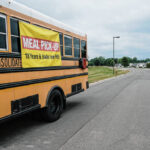
Mike Wolanin | The Republic A school bus being used to give out lunches from Taylorsville Elementary School is parked at Heritage Heights near Taylorsville, Ind., Thursday, July 7, 2022.
As the new school year approaches, families will have to readjust to a new — yet familiar — reality, not every student will receive free breakfast and lunch anymore.
The federal pandemic aid that allowed for universal free meals ended on June 30, said Bartholomew Consolidated School Corp. Director of Food Services Nancy Millspaugh.
“Parents will want to apply for free or reduced meal eligibility using our free or reduced meal applications to see if they qualify,” she said. These applications can be found on BCSC’s website and will also be available at open houses, schools and the transportation and maintenance building.
Millspaugh said that families should file their applications as soon as possible so that the department can process them as quickly as possible. This can be done before the school year starts.
According to the Indiana Department of Education, 4,686 BCSC students — about 40% out of a district population of almost 11,700 — were marked as “free/reduced price meals” for 2021-22. For Flat Rock-Hawcreek, the number was 431 out of 967, or about 45%.
These numbers represent “all students who have applied and been approved to receive free/reduced price benefits, along with students who are automatically eligible because of their participation in SNAP (Supplemental Nutrition Assistance Program) or TANF (Temporary Assistance for Needy Families), or their status as a foster or homeless student,” said Holly Lawson, deputy director of communications.
Universal free meals led to a sizable increase in participation, said Millspaugh.
BCSC’s food services department served about 780,000 lunches during the 2019-20 school year. The provision to offer universal free meals began at the end of September 2020. In 2020-21 — a year somewhat disrupted by eLearning and hybrid education — about 800,000 lunches were served. For 2021-22, the figure was just more than 1.05 million.
U.S. Department of Agriculture Food and Nutrition Service Administrator Cindy Long reported that, during the last school year, about 30 million children a day received free meals. Before the pandemic, the number was 20 million.
“I think participating in the universal free meals, it takes away the stigma of having an income-based program, so it allows everyone to get the nutrition that they need for learning,” said Millspaugh. “It also provides some reliability for kids and families during still a challenging time.”
“More kids ate,” said cafeteria worker and BCSC parent Haley Collins. “We were serving 600 kids a day (for lunch). I expect it to drop tremendously.”
For the upcoming year, there may be issues with families not applying for free and reduced meals, as this was not necessary under the pandemic provisions, Collins said.
Students who are unable to pay will receive a simpler, complimentary meal, she said. “Or it comes out of our pockets,” said Collins. “And I paid for a lot of the kids’ extra stuff this year.”
Students can charge for lunch, but there is a limit. According to BCSC’s website, the practice is “discouraged,” and students may only charge three lunches.
“After that, they will be provided a complimentary peanut butter sandwich, vegetable, and milk until charged lunches have been paid in full,” the site states.
However, while federal provisions for universal free meals have expired, some states have taken action to continue the practice. According to the Associated Press, California and Maine made universal meals permanent last year, and Vermont is continuing free meals for another year by using surplus state education funding.
When asked if Indiana had taken any action, Millspaugh replied that she was not aware of any provisions from the state, though she would appreciate it if lawmakers could consider it during their discussion on tax rebates.
“I’m really concerned about students and families really having to struggle to decide where to spend their money, whether they’re going to be able to provide lunch for their child, whether they’re going to have to buy medicine, whether they’re going to have to put it towards books or gas costs or food for their home,” she said. “It’s a challenging time for everyone, with the economy the way it is right now. And I just really feel that students and families have so much to worry about these days. I don’t think food should be one of those worries.”
While universal free meals will not be offered during the school year, BCSC is serving free summer meals through the Summer Food Service Program and will continue to do so through the end of July. Unlike breakfast and lunches during the school year, these meals are always free to all kids because they are served at “categorically eligible sites,” said Millspaugh.
Congress also recently passed the “Keep Kids Fed Act,” which gives schools some flexibility in regards to meals.
“That provided increased federal reimbursement for school meal systems with their supply chain issues and labor shortages,” said Millspaugh. “It provided leniency in administrative guidelines, like not fining schools for not meeting their nutritional standards during the supply chain issues. And then it provided flexibility in school meal regulations.”
For instance, according to the USDA, the act provides schools with the ability to once again “respond to health-related safety issues by offering grab-and-go and/or parent-pickup of meals.”
Unfortunately, by the time these new regulations are delivered at a state level, BCSC will have finished its summer meals program, which wraps up on July 29. The school corporation saw a significant decrease in participation because they were no longer able to offer “grab and go” distribution, said Millspaugh. Instead, families have had to eat on-site.
“Our first week, we served 162 kids,” said Collins, who has been working a BCSC meal site at the Heritage Heights mobile home park. “And then we were told they weren’t allowed to leave with the food. So the very next day, only 15 people were fed. And we threw away 185 meals. So that was pretty upsetting.”
Bus driver and BCSC parent Isheka Randon, who makes deliveries to the site, agreed and said that wasting food “is not an option.” She would like to see more community members take advantage of summer meals.
When asked if some people feel there is stigma to applying for free or reduced meals, Randon replied that it depends on your perspective.
“But in my opinion, it’s just for families that need help,” she said. “At the end of the day, it’s for the kids. The kids are the main goal, to ensure that they get their education and get fed. So we need to shy away from having that stigma and so people can be more willing and open to apply for it.”
Mike Wolanin | The Republic Haley Collins, left, and bus driver Isheka Randon pose for a photo while they wait to hand out lunches from Taylorsville Elementary School at Heritage Heights near Taylorsville, Ind., Thursday, July 7, 2022.
Mike Wolanin | The Republic Bags of lunches from Taylorsville Elementary School are shown on a parked bus at Heritage Heights near Taylorsville, Ind., Thursday, July 7, 2022.
Mike Wolanin | The Republic A school bus being used to give out lunches from Taylorsville Elementary School is parked at Heritage Heights near Taylorsville, Ind., Thursday, July 7, 2022.
Mike Wolanin | The Republic Haley Collins, left, and bus driver Isheka Randon pose for a photo while they wait to hand out lunches from Taylorsville Elementary School at Heritage Heights near Taylorsville, Ind., Thursday, July 7, 2022.








